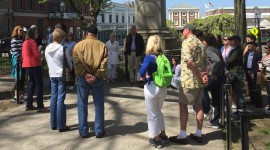Landscape Information
The boundaries of this 265-acre farm on the western coast of Conanicut Island coincide closely with those established in a survey of 1657 by Joshua Fisher, who first divided portions of the island into agricultural allotments. The plot was assigned to William Brenton, Governor of the Colony of Rhode Island, who employed tenant farmers to cultivate it. The land passed among several owners in the seventeenth and eighteenth centuries, including Job Watson, whose son, Robert, built the present-day farmhouse (circa 1796), and whose heirs would retain the property for five generations. In 1979 Thomas Carr Watson, Jr. bequeathed the parcel to the Society for the Preservation of New England Antiquities (SPNEA, now Historic New England), stipulating its continuation as a working farm.
From North Road on the east, a gravel lane leads through mature trees and wooded swamp, which opens to a yard with a farmhouse, barns, and several outbuildings, as well as a vegetable garden and, in the distance, a windmill. To the south, hayfields are shielded by a hedgerow, while to the west views open to seaside pastures and, eventually, Narragansett Bay. Historic fieldstone walls mark the boundaries of the property, as well as internal divisions of pasturage and orchards, just as they did in the seventeenth century. In the early 1980s SPNEA renovated the farmhouse and barns, and returned the land to the hands of tenant farmers, who have instituted rotational grazing; heritage Red Devon cattle were introduced in 2003. The farm is regularly open for self-guided tours, educational programs, and events.












